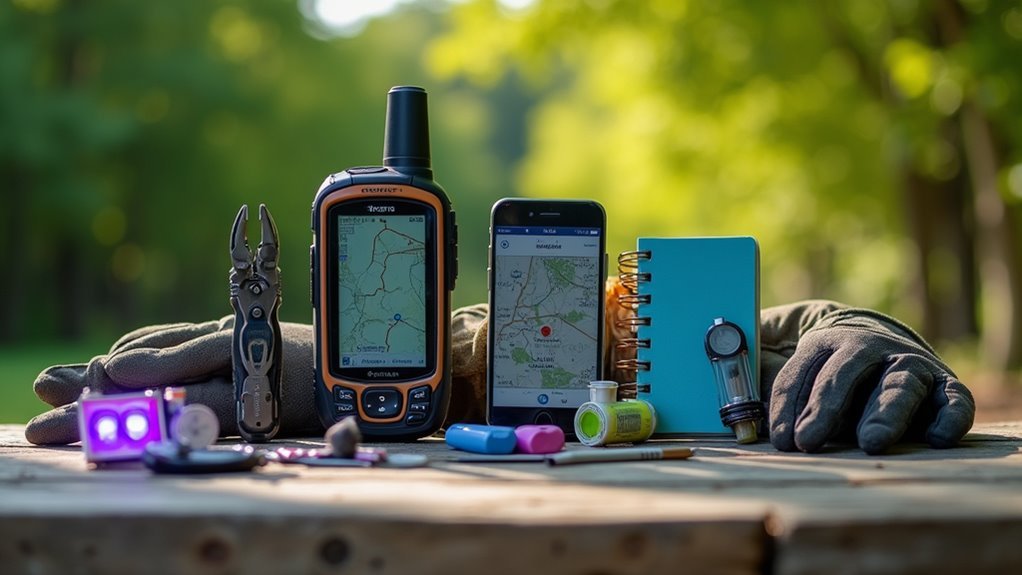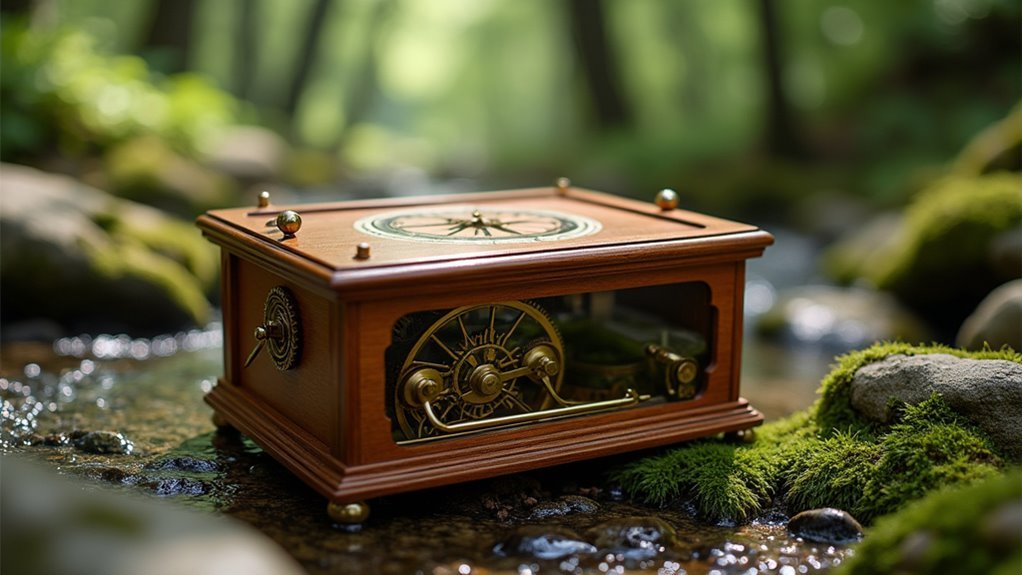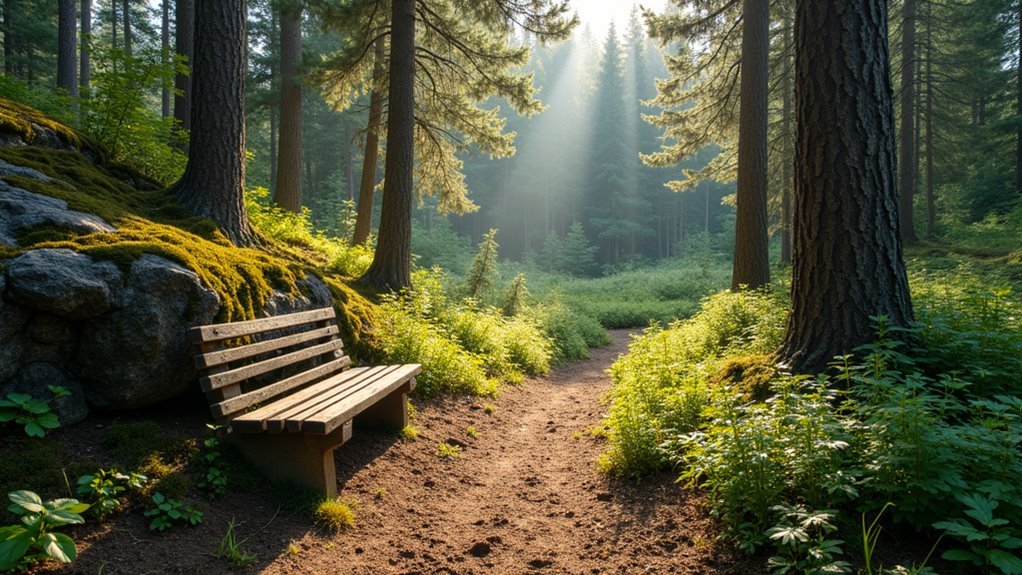Some of the links in this article may be affiliate links. If you make a purchase through these links, we may earn a small commission at no extra cost to you. Thank you.
You might not realize that multi-stage geocaches require more strategic planning than traditional single-spot hides. I’ve created over fifty multi-caches, and I’ve found that the most memorable ones use progressive challenges that build upon each other. Designing a sequence where each discovery reveals a clue to the next stage transforms a simple treasure hunt into an immersive adventure. Want to know how to craft experiences that’ll have cachers talking for months?
Gadgets and Tools: Essential Equipment for Multi-Stage Caches

A well-stocked geocacher’s bag can mean the difference between triumph and frustration when tackling multi-stage caches.
I’ve learned the hard way that even the best GPS devices can’t help if you’re missing essential tools for the journey.
In my experience, you’ll want to pack a magnifying glass for those tiny numbers hidden on camouflaged surfaces.
Don’t forget a number 2 pencil – I’ve encountered many caches where it’s needed to activate mechanisms in features like barnwood birdhouses.
Four AA batteries for your flashlight, some string, a ruler, and a small mirror are also must-haves.
These tools complement your GPS units or official Geocaching apps perfectly.
Well, I think the adventure is more fun when you’re prepared, right?
Coordinate Concealment Techniques and Puzzle Integration
Now that you’ve got your toolkit ready, let’s talk about the creative ways coordinates can be disguised in multi-stage geocaches. I’ve found that puzzle writers often use artificial turf with camouflaged numbers requiring a magnifying glass to reveal them.
In my experience with Geocaching and related topics, you can integrate mechanisms like a number 2 pencil inserted into a birdhouse hole to expose backward coordinates—you’ll need a mirror for that!
Looking for backward coordinates? Try the number 2 pencil trick with a birdhouse and mirror—it’s geocaching ingenuity at its finest!
Some clever cachers follow Adventure Lab Guidelines by concealing coordinates under pennies in containers, forcing players to remove them to discover the truth.
When discussing creating Adventures, don’t forget etching backward coordinates on metal pieces. According to the Help Center for Adventure Lab, tools like rulers and string are essential aspects of trackables for measuring hidden elements in these multi-stage puzzles.
Physical Mechanisms and Interactive Elements

When I’m creating multi-stage geocaches, I love incorporating mechanical puzzle triggers that require specific physical actions—like pushing a hidden button or aligning wooden pieces—to reveal the next set of coordinates.
You’ll find that the most memorable caches often demand specialized tools, whether it’s a small mirror to reflect light onto a sensor or a magnet to activate a hidden switch.
I think the real magic happens when cachers must physically interact with the environment, maybe by counting steps between landmarks or measuring the precise angle of sunlight through a specific opening at a certain time of day.
Mechanical Puzzle Triggers
Mechanical puzzles transform ordinary geocache containers into interactive adventures that’ll keep players engaged for hours.
I’ve found that using birdhouses with plexiglass bottoms can create incredible puzzle triggers – just like one I designed where a pencil activates a hidden coordinate reveal mechanism.
It reminds me of how the Project APE Cache uses interactive elements that make caching more immersive.
You don’t need fancy Trackable inventory on cache pages to create magic.
Simple materials work wonders!
Try using mirrors to reveal backward-written coordinates, or hidden flaps illuminated by flashlights.
One of my favorite aspects of trackables is how they can integrate with mechanical elements – like those 15 pennies covering coordinates in a Tupperware container.
The Geocaching Help Center offers great tips for these designs!
Hidden Coordinate Reveals
How do you elevate a geocache from ordinary to extraordinary? It’s all about creating those “aha!” moments with cleverly hidden coordinates. I’ve found that placing GPS coordinates under artificial turf or inside birdhouse mechanisms really makes cachers feel like they’ve accomplished some geocaching-related task that others might miss.
| Reveal Mechanism | Equipment Needed | Example Usage | Effect on Cacher | Difficulty |
|---|---|---|---|---|
| Hidden Text | Magnifying glass | Under turf | Surprise | Medium |
| Mechanical Trigger | #2 pencil | Birdhouse | Satisfaction | Hard |
| Light Activation | Flashlight | Dark spaces | Discovery | Medium |
| Mirror Reading | Pocket mirror | Backward text | Intrigue | Easy |
| Weight Concealment | None | Pennies on text | Challenge | Medium |
With official Geocaching® apps supporting paperless caching, these physical reveals make trackables and inventory on cache logs feel special. It’s what gets people talking in discussions about Global Positioning adventures.
Tools-Required Challenges
Why not transform your ordinary geocache into a gadget-lover’s paradise?
While sales of GPS units have declined with Geocaching® apps for iPhone taking over, there’s still something magical about combining traditional GPS devices with physical tools.
In my experience, the best multi-stage caches incorporate interactive elements that make trackables more engaging.
Here are four essential tool-based challenges to include:
- Magnifying glass puzzles – Create tiny coordinates on camouflaged surfaces that can’t be seen without magnification
- Mechanical triggers – Design a system where a #2 pencil activates a hidden compartment
- Light-dependent reveals – Use backward-printed text that’s only visible when illuminated with a flashlight
- Measurement challenges – Incorporate string and rulers for precise alignment of experimental features
I think these aspects of trackables will truly elevate your cache design!
Environmental Considerations and Location Selection

When selecting locations for your multi-stage geocache, environmental impact should be at the forefront of your planning process.
I’ve found that protected areas like the Sleepy Creek Wildlife Area provide an ideal platform for creative caches while preserving natural features.
Before finalizing your site, take inventory of the terrain – a 3.5 rating, for instance, guarantees your cache is accessible without disturbing sensitive areas.
I always follow local guidelines and leave notes about trackables and related environmental considerations in my cache thread.
You’ll want to integrate stages with natural elements – rocks make perfect hiding spots!
When I place caches, I gather feedback from fellow geocachers on environmental impact.
Progressive Difficulty: Building Challenge Across Stages
When I’m designing multi-stage geocaches, I always think about creating skill-building waypoints that gradually increase in complexity—like how the Sleepy Creek cache evolves from simple magnifying glass work to that tricky rock formation challenge.
You’ll want to distribute your challenges strategically, starting with something accessible to hook participants before ramping up the difficulty with each subsequent stage.
I’ve found that this progressive approach not only prevents frustration but actually enhances satisfaction when cachers finally reach that final container after overcoming increasingly sophisticated obstacles.
Skill-Building Waypoints
How exactly do you create a multi-stage geocache that keeps players engaged from start to finish?
I’ve found that designing skill-building waypoints is all about progressive challenges that develop cachers’ abilities through the journey.
When I created my Sleepy Creek multi-cache, I deliberately structured it to build competence with each stage.
Here’s my approach to crafting skill-building waypoints:
- Start with basic observation skills (like using a magnifying glass to find camouflaged coordinates)
- Introduce simple tools and interactions (such as the birdhouse mechanism requiring a pencil and flashlight)
- Add tactile challenges that require patience (removing pennies to reveal hidden numbers)
- Culminate with complex problem-solving that integrates earlier skills (using mirrors to decode backward-etched coordinates)
Each waypoint should teach something useful for the next challenge!
Strategic Challenge Distribution
The strategic distribution of challenges throughout your multi-stage geocache is perhaps the most essential element for maintaining player engagement. I’ve found that starting with simpler tasks—like using a magnifying glass to find camouflaged coordinates—builds confidence before introducing more complex challenges.
| Stage | Tools Required | Cognitive/Physical Demands |
|---|---|---|
| Early | Basic (magnifying glass) | Low – builds confidence |
| Middle | Multiple (pencil, flashlight) | Moderate – requires precision |
| Final | Complex (mirror, string, ruler) | High – involves problem-solving |
When designing your multi-stage cache, I think it’s important to take into account how manual dexterity and cognitive demands increase progressively. For instance, that penny-filled Tupperware in stage three requires careful manipulation, while the mirror-reading task introduces hazard navigation. This progressive difficulty curve keeps cachers invested throughout the entire experience—they’re learning as they go!
Maintenance and Longevity of Complex Cache Designs
Maintaining complex multi-stage geocaches isn’t just about creating them—it’s about keeping them alive and functioning for years to come.
When I place a cache with multiple features, I’m committing to regular maintenance checks, especially for trackables and experimental features in outdoor sites like Sleepy Creek Wildlife Area.
Every aspect of your cache needs attention to stay within guidelines and work properly. I recommend:
- Inspect materials monthly – Check artificial turf, barnwood, and plexiglass for weather damage
- Replace consumables regularly – Those 4 AA batteries won’t last forever!
- Verify coordinate readability – Etched steel coordinates maintain better than paper
- Document maintenance visits – Reports help track when aspects of your cache need attention
Well-maintained caches with multiple stages will keep geocachers coming back for years.
Frequently Asked Questions
How Do I Discourage Geocache Muggling Without Deterring Legitimate Finders?
I plant my caches like hidden gems in plain sight. I use stealth placement, durable materials, and muggle education signage while tracking my caches regularly. Verification apps and community alerts help identify true finders.
What Safety Protocols Should Be Implemented for Night-Accessible Multi-Caches?
I’d recommend NightLighting, ReflectiveGear, PathMarkers, HazardIdentification, FirstAid kits, WeatherPreparedness, CommunicationPlans, EmergencyProcedures, GroupSafety protocols, and WildlifeAvoidance strategies. Never geocache alone at night without telling someone your route.
When Should I Reveal the Final Container Type to Cachers?
I prefer to integrate container hints strategically—teasing the final without full disclosure. I’ll reveal just enough to build curiosity while maintaining surprise elements that enhance your multi-cache experience, balancing secrecy with engagement tactics.
How Much Storytelling Should Be Incorporated Into Multi-Cache Descriptions?
I’d aim for NarrativeBalance—enough StoryIntegration to create interest without overwhelming. ThemeExploration and HistoricalIncorporation can enhance EmotionalEngagement, but I keep PlotDepth proportional to the cache’s complexity. MysteryNarratives work wonderfully!
What Permissions Are Needed for Caches Spanning Multiple Property Jurisdictions?
I’ll need property consents from each landowner whose jurisdiction my cache crosses. Legal boundaries require multi-owner approval and territorial agreements, while regulatory compliance means securing authority clearances and zoning permits before creating cross-jurisdiction access points.